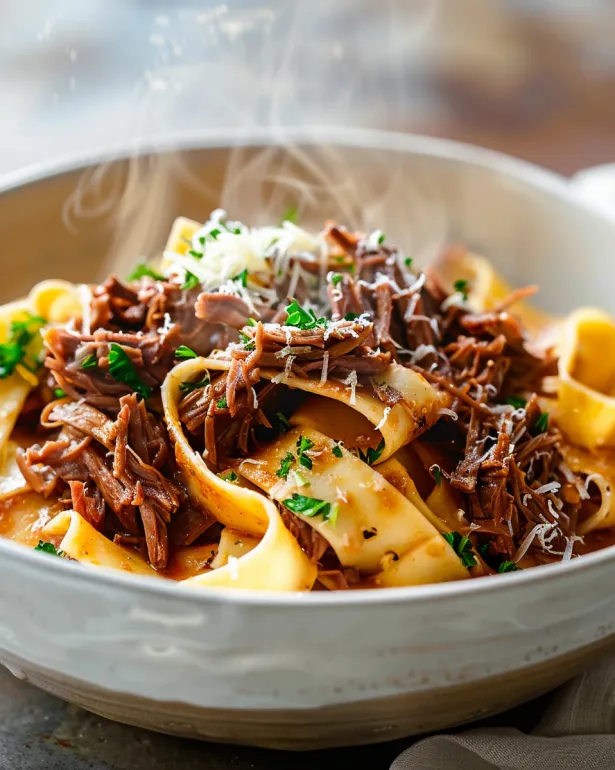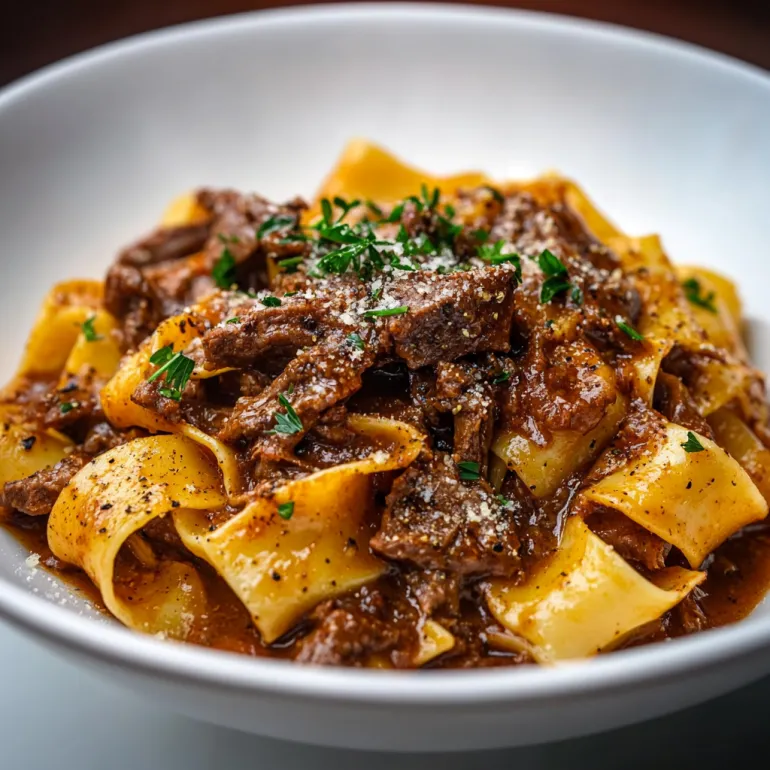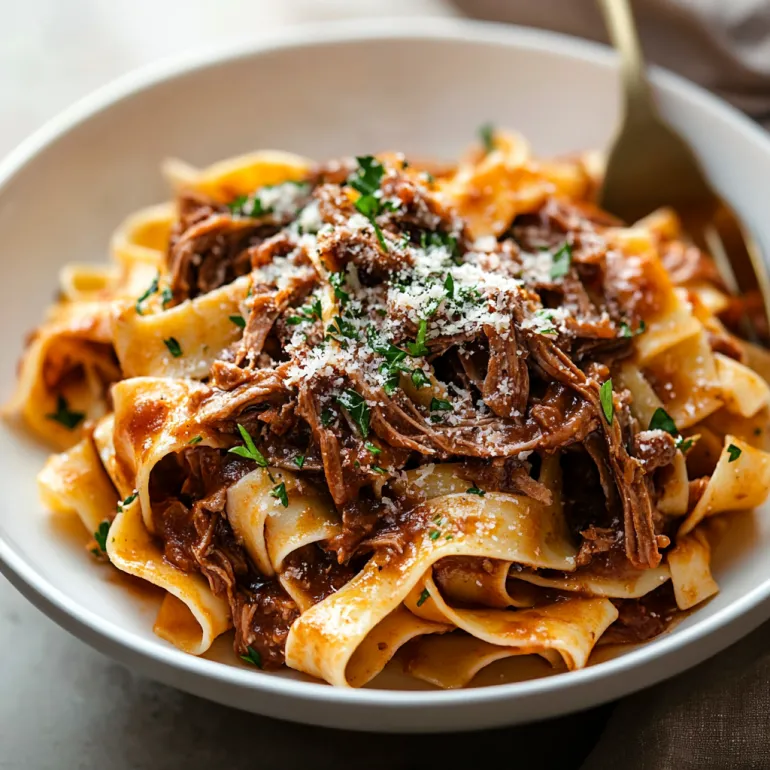 Pin
Pin
Nothing beats a slow-cooked beef ragu when you crave comfort and want your kitchen to smell incredible all afternoon. This is my favorite weekend recipe to make when I want to spoil my family with something rich and satisfying. While it simmers, I set the table, pop open a bottle of red, and know I am creating a memory along with a meal.
The first time I made this on a chilly Sunday, we ended up lingering at the table long after dinner was done. The leftovers only got better the next day, and now this ragu is a staple for our family gatherings.
Ingredients
- Olive oil: provides a rich base for browning meat and vegetables and helps everything meld together
- Chuck roast: look for even marbling and bright color this cut melts into tender shreds
- Onion: choose a heavy firm onion for the sweetest flavor when cooked down
- Fresh garlic: the more cloves the better for depth of flavor use firm heads without any green shoots
- Beef broth: adds meaty flavor make sure it is low sodium so you can control seasoning
- Tomato paste: reaches a deeper flavor with a quick sauté look for deep red vibrant paste
- Balsamic vinegar: lift and brighten the sauce shop for a high quality aged vinegar if possible
- Crushed tomatoes and diced tomatoes: give the sauce wonderful texture and a balanced tang
- Parmesan rind: releases a subtle nuttiness as it stews opt for Italian parmesan if you have it but it is optional
- Bay leaves and fresh thyme: bring an earthy undertone use fragrant leaves and vibrant green thyme
- Basil: adds an herbal lift use a generous handful of fresh bright green leaves
- Sugar: a small pinch balances acidity of the tomatoes
- Red pepper flakes: give gentle heat crush them yourself for more potency
- Pappardelle or wide ribbon pasta: catches all the saucy shreds use bronze-cut pasta if available
- Parsley and parmesan cheese: for a finishing freshness and savory bite look for flat leaf parsley and freshly grated parmesan
Step-by-Step Instructions
- Sear the Beef:
- Get your Dutch oven hot add the oil and brown the chuck roast pieces on all sides. Let each side develop a deep golden crust which takes about five to seven minutes per side. Remove the beef pieces and set aside.
- Build the Base:
- Add more oil if needed and cook the chopped onions over medium-low heat for four to five minutes. Keep stirring so they turn soft and translucent but never brown. Follow with the garlic letting it simmer for one to two minutes to release its fragrance.
- Deepen the Flavor:
- Spoon in the tomato paste and stir constantly for a full minute so it darkens in color. This tiny step transforms the sauce into something rich and restaurant worthy.
- Deglaze and Simmer:
- Pour in the beef broth and immediately scrape up any cooked bits stuck to the pot for maximum flavor. Add the balsamic vinegar both tomatoes parmesan rind bay leaves thyme basil sugar and red pepper flakes. Stir everything together and wait for the sauce to simmer then nestle the beef pieces back in.
- Slow Cook Until Tender:
- Cover the pot lower the heat to the very lowest setting and let the ragu cook for two and a half to five hours. Check every hour or so and add a splash of broth or water if it is drying out. The beef is ready when it shreds easily with a fork. Shred the beef right in the sauce and let simmer another ten to fifteen minutes so the flavors fully meld.
- Finish and Serve:
- Taste your sauce and add salt if needed. Remove any bay leaves parmesan rind and bruised basil. Spoon rich ragu over bowls of pappardelle top with parsley and freshly grated parmesan. Serve immediately and watch everyone reach for seconds.
 Pin
Pin
Storage Tips
Cool leftovers completely then refrigerate in tightly sealed containers for up to four days. For longer storage freeze in portioned containers for up to three months. When reheating add a splash of water or beef broth to bring back the sauce’s silky texture.
Ingredient Substitutions
Chuck roast is classic but you can swap in eye of round or even brisket. For a lighter take use boneless short ribs. If you only have dried herbs swap in dried thyme and basil but reduce the amount by half. Gluten free pappardelle or even creamy polenta work beautifully for gluten sensitive eaters.
Serving Suggestions
Serve the ragu piled high over pappardelle or any wide pasta. Sprinkle with lots of fresh parsley and parmesan cheese. For a Sunday feast I like to set out crusty bread to mop up the sauce and a simple green salad on the side. This ragu also makes wonderful sliders or can be spooned over soft polenta.
 Pin
Pin
Cultural and Historical Context
Ragu is rooted in the long tradition of Italian slow-cooked sauces made to stretch affordable cuts of meat. Italian nonnas often simmered their sauce all afternoon filling kitchen with anticipation. While many families have their version I swear by the extra step of adding a parmesan rind for authentic flavor.
Frequently Asked Questions About the Recipe
- → What cut of beef is best for braising with pappardelle?
Chuck roast works well due to its marbling, which becomes tender after slow cooking. Eye of round is another option, though it may require longer braising time.
- → Is searing the beef necessary before simmering?
Searing builds deeper flavor by caramelizing the meat's exterior, adding complexity to the final sauce.
- → Can the sauce be prepared in advance?
Yes, the braised beef sauce improves as it sits, making it ideal for preparing a day ahead and reheating before serving.
- → How do I prevent the sauce from drying out during braising?
Check liquid levels occasionally and add splashes of beef broth or water as needed to keep the sauce lush.
- → What garnishes pair well with this dish?
Fresh parsley and grated parmesan add brightness and richness to complement the savory beef and pasta.
